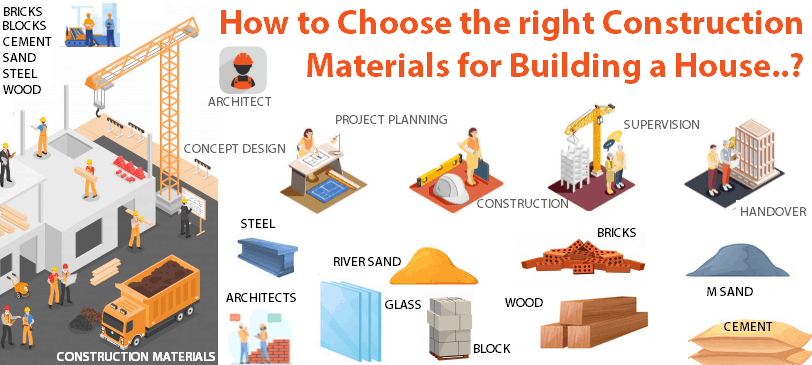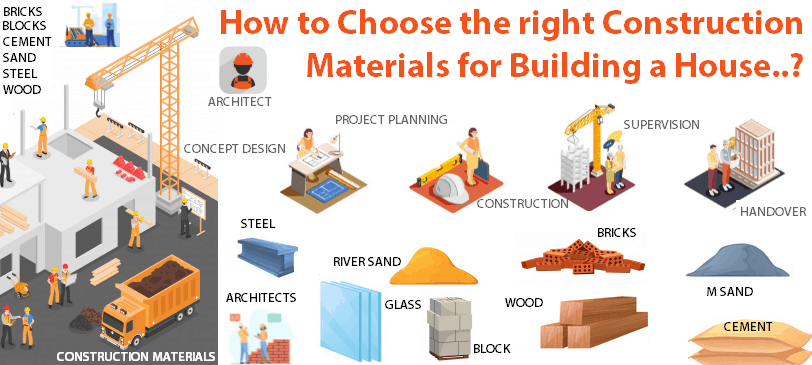How To Choose The Right Materials For Your Building Architecture
Building architecture is a complex process that requires careful consideration of many factors. One of the most important aspects of building design is choosing the right materials. Selecting the right materials is critical to ensure that your building is structurally sound, aesthetically pleasing, and meets all safety standards. But with so many options available, it can be overwhelming to know where to start. In this article, we will guide you through the process of choosing the right materials for your building architecture.
Choosing the Right Materials for Your Building Architecture
Building architecture is an art that involves designing and constructing buildings that are functional, safe, and aesthetically pleasing. One of the most important aspects of building architecture is selecting the right materials. The selection of materials plays a crucial role in determining the durability, safety, and aesthetics of a building. In this article, we will discuss how you can choose the right materials for your building architecture.
1. Consider the Building’s Purpose and Location
The purpose and location of the building are important factors to consider when choosing materials. For example, a building located in a high-temperature zone will require materials that can withstand high temperatures. Similarly, a building that is designed for heavy industrial use will require materials that are strong and durable. You should also consider the intended use of the building when selecting materials. A residential building will require different materials than a commercial building.
When choosing materials, consider the climate, weather patterns, and soil conditions in the area. This will help you select materials that are resistant to weathering and erosion. Additionally, consider the environmental impact of the materials. Choose materials that are sustainable and eco-friendly.
2. Evaluate the Cost of Materials
The cost of materials is an important consideration when choosing materials for your building architecture. The cost of materials will depend on their availability, quality, and durability. High-quality materials may be more expensive, but they can save you money in the long run by reducing maintenance costs and increasing the lifespan of the building.
When evaluating the cost of materials, consider the entire life cycle of the building. Choose materials that are cost-effective and provide the best value for your money. You should also consider the installation and maintenance costs of the materials.
3. Assess the Durability and Strength of Materials
The durability and strength of materials are important considerations when choosing materials for your building architecture. The materials should be able to withstand the weight and stress of the building. They should also be resistant to damage from weathering, erosion, and other environmental factors.
When assessing the durability and strength of materials, consider their lifespan and maintenance requirements. Choose materials that require minimal maintenance and have a long lifespan. This will help you save money on maintenance costs and ensure that the building is safe and secure.
4. Consider the Aesthetics of Materials
The aesthetics of materials are an important consideration when choosing materials for your building architecture. The materials should be visually appealing and complement the overall design of the building. They should also be able to withstand the test of time and maintain their appearance over the years.
When considering the aesthetics of materials, consider the color, texture, and pattern of the materials. Choose materials that enhance the beauty of the building and create a welcoming environment.
5. Evaluate the Environmental Impact of Materials
The environmental impact of materials is an important consideration when choosing materials for your building architecture. Choose materials that are sustainable and eco-friendly. The materials should be able to reduce the carbon footprint of the building and minimize its impact on the environment.
When evaluating the environmental impact of materials, consider their production process, transportation, and disposal. Choose materials that are produced using renewable resources and are recyclable or biodegradable.
6. Consider the Availability of Materials
The availability of materials is an important consideration when choosing materials for your building architecture. Choose materials that are readily available and can be sourced locally. This will help you save money on transportation costs and reduce the environmental impact of the building.
When considering the availability of materials, consider their demand and supply. Choose materials that are in high demand and have a stable supply chain. This will help you avoid delays in the construction process.
7. Evaluate the Fire Safety of Materials
The fire safety of materials is an important consideration when choosing materials for your building architecture. Choose materials that are fire-resistant and can withstand high temperatures. This will help you reduce the risk of fire and ensure the safety of the occupants.
When evaluating the fire safety of materials, consider their fire resistance rating and ignition point. Choose materials that have high fire resistance ratings and a high ignition point.
8. Consider the Thermal Insulation of Materials
The thermal insulation of materials is an important consideration when choosing materials for your building architecture. Choose materials that provide good thermal insulation and can help you save energy. This will help you reduce your energy bills and create a comfortable indoor environment.
When considering the thermal insulation of materials, consider their R-value and U-value. Choose materials that have a high R-value and a low U-value. This will help you reduce heat loss and gain.
9. Evaluate the Sound Insulation of Materials
The sound insulation of materials is an important consideration when choosing materials for your building architecture. Choose materials that provide good sound insulation and can help you create a peaceful indoor environment. This is especially important in buildings that are located in noisy areas.
When evaluating the sound insulation of materials, consider their sound transmission class (STC) rating. Choose materials that have a high STC rating and can block out unwanted noise.
10. Consider the Maintenance Requirements of Materials
The maintenance requirements of materials are an important consideration when choosing materials for your building architecture. Choose materials that require minimal maintenance and can withstand wear and tear. This will help you save money on maintenance costs and ensure that the building is safe and secure.
When considering the maintenance requirements of materials, consider their cleaning requirements, repair needs, and lifespan. Choose materials that require minimal cleaning and repair and have a long lifespan. This will help you reduce maintenance costs and ensure the longevity of the building.
In conclusion, choosing the right materials for your building architecture is an important decision that requires careful consideration. Consider the purpose and location of the building, the cost of materials, their durability and strength, aesthetics, environmental impact, availability, fire safety, thermal insulation, sound insulation, and maintenance requirements. By following these guidelines, you can choose materials that are safe, durable, cost-effective, and environmentally friendly.
Frequently Asked Questions
Choosing the right materials for your building architecture is an important decision that requires careful consideration. Here are some common questions and answers to help you make the right choice.
What factors should I consider when choosing building materials?
There are several factors to consider when choosing building materials, including:
1. Durability: How long will the materials last?
2. Cost: How much will the materials cost?
3. Aesthetics: Do the materials fit the desired aesthetic?
4. Maintenance: What kind of maintenance will the materials require?
5. Sustainability: Are the materials environmentally friendly?
How do I know if the materials are durable?
You can determine the durability of building materials by considering their resistance to wear and tear, weathering, and decay. You should also research the lifespan of the materials and their ability to withstand the elements in your specific location. Materials that are known for their longevity and resistance to damage, such as brick, concrete, and stone, are good choices for durable construction.
It’s also important to consider the quality of the materials and the reputation of the manufacturer. Be sure to choose materials from reputable suppliers that have a track record of producing high-quality products.
What are some environmentally friendly building materials?
There are many environmentally friendly building materials to choose from, including:
1. Recycled materials: These materials are made from waste products and can be reused in construction.
2. Sustainable wood: Wood from sustainably managed forests is a renewable resource that can be used as an environmentally friendly building material.
3. Bamboo: Bamboo is a fast-growing and renewable resource that can be used for flooring, furniture, and other building materials.
4. Insulation made from recycled materials: These materials provide good insulation and reduce energy consumption.
5. Low VOC paints and adhesives: These materials release fewer harmful chemicals into the environment.
How do I balance cost and quality when choosing building materials?
When choosing building materials, it’s important to find a balance between cost and quality. While it may be tempting to choose cheaper materials to save money, you may end up paying more in the long run if the materials are of poor quality and require frequent repairs or replacements.
One way to balance cost and quality is to prioritize the most important factors for your specific project. For example, if durability is a top priority, it may be worth investing in higher-quality materials that will last longer. On the other hand, if you have a tight budget, you may need to compromise on certain aspects such as aesthetics or sustainability.
What should I do if I’m unsure about which materials to choose?
If you’re unsure about which materials to choose for your building project, it’s a good idea to consult with a professional architect or builder. They can provide you with expert advice based on your specific needs and budget. You can also do research online and read reviews from other homeowners or builders who have used similar materials. Visiting showrooms or attending trade shows can also give you a better idea of what materials are available and how they look and feel.
Ultimately, the key to choosing the right materials for your building architecture is to do your research, consider your priorities, and seek advice from trusted professionals.
Choosing Architectural Materials
In conclusion, choosing the right materials for your building architecture is a crucial step in the construction process. It not only affects the overall aesthetic of the building but also its structural integrity and durability. With so many options available, it can be overwhelming to make a decision. However, by considering factors such as climate, budget, and design goals, you can narrow down your choices and select the best materials for your project.
Remember to prioritize functionality over style when selecting materials. While it is important to have an attractive building, it is even more important that it is safe and sustainable. Additionally, ensure that the materials you choose meet local building codes and regulations.
Lastly, don’t be afraid to consult with experts in the field. Architects, engineers, and contractors can provide valuable insight and guidance when it comes to selecting materials for your building. By working together, you can create a beautiful and functional structure that will stand the test of time.




Leave a Reply